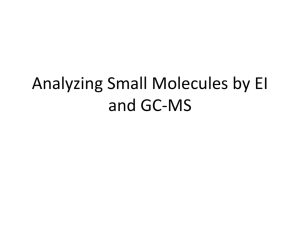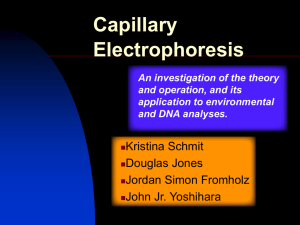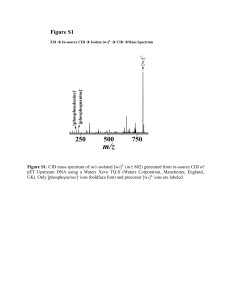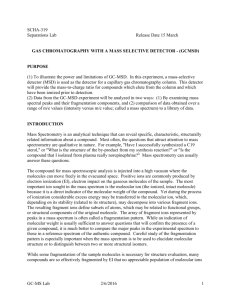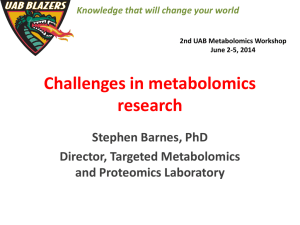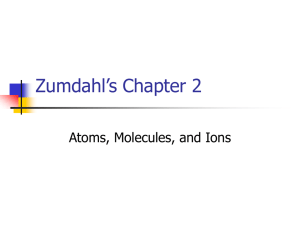Useful information about MS-based metabolomics
advertisement
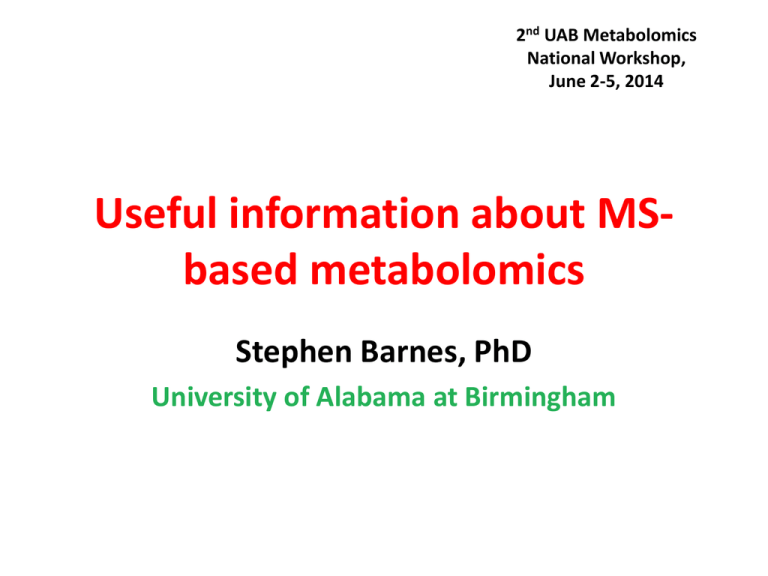
2nd UAB Metabolomics National Workshop, June 2-5, 2014 Useful information about MSbased metabolomics Stephen Barnes, PhD University of Alabama at Birmingham Different MS approaches • Gas chromatography-mass spectrometry (GCMS) – This was the original method (still used) – Relies on making stable, volatile derivatives of the metabolites – Typically limited to masses up to 350-400 Da • Liquid chromatography-mass spectrometry (LCMS) – Does not (necessarily) require derivatization – By convention, masses up to 1500 Da Basis of Chromatography • A moving (mobile) phase passes over an inert, stationary phase – The compounds differentially interact with the stationary phase and elute at different times The stationary phase can be paper, silica, coated silica and derivatized silica The mobile phase can be a gas or a liquid (organic solvent or water) GC • The stationary phase is a solid coated or chemically bonded with a liquid phase – These days it is a coating or material bonded onto the interior wall of a capillary tube (usually quartz) • The moving (mobile) phase is a gas – N2 or He – Now H2 • Elution occurs with a stable flow rate and temperature programming Capillary GC • Packed columns had size limitations due to the pressure drop across the column (5000 plates) • Van Deemter equation: – Height of theoretical plate (HETP) (lower the better) – HETP = A + B/u + C*u where u = linear velocity – The compressibility of a gas means that the linear flow velocity is lower at the top of the column • By using open tubular capillary columns, the pressure drop is minimized and columns up to 100 meters are common (>100,000 plates) Coated capillary columns • The liquid phase is either applied as a thin film on the inside wall of the quartz capillary, or is chemically bonded (more temperature stable) GC-GC In this approach, fractions from the first GC column are orthogonally analyzed on a second, different GC column 2D-GC x GC reveals hidden peaks buried in major peaks in a 1D separation GC-MS • Consists of several steps: sample injection, compound separation, gas phase transfer, mass analysis GC x GC-TOF-MS Compounds emerging from the second column can be ionized and analyzed by time-of-flight MS analysis GC-MS • Compounds eluting from the capillary GC are ionized by an electron beam (70 eV) – Ions have a mass-to-charge ratio (m/z) – Only rarely is the molecular ion observed, but many fragment ions are in the spectrum GC-MS mass analyzers • Ions are filtered one at a time (mass window of 0.2-0.7 Da) through a quadrupole mass filter Robust, but low mass resolution and slow GC-MS TOF analyzer Note that all the ions reach the detector. The analysis is very fast (< 1 msec) and it has much higher mass resolution (up to 40,000) and mass accuracy (2-3 ppm) than a quadrupole GC-triple quadrupole-MS/MS Ions selected by the 1st quadrupole are collisionally dissociated and analyzed by the 3rd quadrupole. Metabolomics and GC-MS • PROS – Capillary columns can achieve very high chromatographic resolution – Retention times are reproducible – Mass spectral libraries are well developed • CONS – Not all compounds can be analyzed by GC-MS – Although amino acids, sugars, fatty acids, amines and organic acids can be derivatized, complex polyphenol glycosides and polar lipids are too unstable, even when derivatized, at the temperatures used to elute them LC • The solid phase is typically silica – The silica surface can be made to be hydrophobic with attached alkyl groups (reverse-phase), or hydrophilic with attached NH2 groups (normal phase) • The mobile phase is a liquid – Gradients of methanol, ethanol, isopropanol, or acetonitrile in water with volatile additives (0.1% formic acid or formic acid, 2-10 mM ammonium acetate or formate) – Trifluoroacetic acid is not used, nor are Tris or phosphate buffers LC-MS • The advantage of an effective LC-MS system would be that it would allow thermally unstable compounds, even large ones (such as proteins), to go into the gas phase from liquid solution and into the mass spectrometer • Importantly, the ionization methods used are soft in nature and molecular ions [M+H]+ or [M-H]- are easily formed (see later re other molecular ions) • However, there are some compounds that cannot be ionized by LC-MS – polycyclic aromatic hydrocarbons, alkanes, waxes. LC-MS interface The key issue is how to transfer ions from the liquid phase into the gas phase while minimizing the transfer of solvent into the mass spectrometer – For compounds that can be charged, electrospray ionization (ESI) is the principal method of choice – Nebulization of the electrical charged droplets more effectively decreases the size of droplets • This allows all aqueous solvents to be processed by the interface – Heating the spray further increases sensitivity • Not used in nanoelectrospray ionization Electrospray Ionization (ESI) N2 curtain gas nebulizing gas sample solution Mass Analyzer +HV Vacuum Atmospheric pressure + + + + + + + +++ + + + + + + [M + nH]n+ + + 1. Solvent evaporation 2. Coulombic repulsion Atmospheric chemical ionization (APCI) • Suitable for compounds that are neutral • A corona discharge needle ionizes air molecules that transfer their energy to the solvent and hence the solutes Guide to LC-MS flow rates Type Column ID Flow rate Solvent consumed* Conventional 1.0-4.6 mm 0.050-1.00 ml/min 72-1440 ml Capillary 0.3-1.0 mm 0.005-0.050 ml/min 7.2-72 ml Nano 0.05-0.20 mm 100-1000 nl/min 0.144-1.44 ml Sensitivity in LC-ESI-MS increases in proportion to the inverse of the flow rate. Therefore, there is value in going to lower flow rates – it also saves money on solvents. ChipLC versus nanoLC • A nanoLC column is so thin (75 mm i.d.) it has very little thermal capacity – this leads to variable retention times due to temperature fluctuations in the lab A column etched in a block of silica can be engineered to have greater physical reproducibility and it has far greater thermal capacity. The CHIP can be placed in temperature-controlled chamber – we operate ours at 55oC – to recover more hydrophobic metabolites Engineered microflow LC Chromatography at flow rates of 5-50 ml/min using 0.3-0.5 mm ID columns Very low dead volumes between the sample injection valve and the ESI interface despite the low flow rate Enables short, reproducible gradients (1-2 min) or up to a 20 min gradient (for metabolomics) at 5 ml/min Column phases • Reverse-phase – C4, C5, C8, C18, phenyl-hexyl-bonded phases • Normal phase – Bare silica, Cyano and amino-bonded phases • Hydrophilic interaction chromatography – Bare silica, polyol-bonded phase • Particle sizes – 5, 3, 2.5, 2.2 mm and 1.7 mm (for UPLC) Mobile phases • Acidic media – Typically 0.1% formic acid • Neutral media – 1-10 mM ammonium acetate or formate • Alkaline media – 0.1% ammonium hydroxide (but not with C4-C18 phases) • Solvents (water-miscible) – Methanol, acetonitrile, isopropanol (for hydrophobic metabolites) Detector types Type Mass range (m/z) Resolution Accuracy (ppm) Time for MSMS (msec) Quadrupole 20-3000 2,000 50 1000 TOF unlimited 30,000-40,000 2-3 50 or less Orbi-trap* 50-6000 80,000-200,000 1-3 200+ FT-ICR* 100-1,500 Up to 1,000,000 <1 1000 *These detectors depend on ion motion and therefore their performance declines as the acquisition time is shortened. Using a 80 msec MSMS acquisition, mass resolution on an Orbi-trap falls to 17,000. The TOF detector is the preferred one for untargeted analysis. The Orbi-trap and FT-ICR instruments are important for follow-up high mass accuracy experiments. Detector combinations • Each detector can record a MS spectrum – Not sufficient even with high mass accuracy to identify the metabolite • 100s of metabolites can have the same empirical formula (and identical mass) • Fragmentation of selected ions creates a MSMS spectrum to distinguish isobaric metabolites – In IDA analysis, molecular ions detected in a quick Hi-Res MS, are “selected” by the quadrupole filter one at a time – The ion is fragmented and a MSMS spectrum recorded • TOF instruments can record 20 MSMS spectra per second Primer for selecting ions for MRM Peak width (sec) Cycle time (sec) Dwell time (msec) Number of channels 5 0.5 20 25 10 1.0 20 50 5 0.5 10 50 10 1.0 10 100 5 0.5 5 100 10 1.0 5 200 5 0.5 2 250 10 1.0 2 500 The number of channels can be increased by using timed windows Combined channels for Krebs cycle
